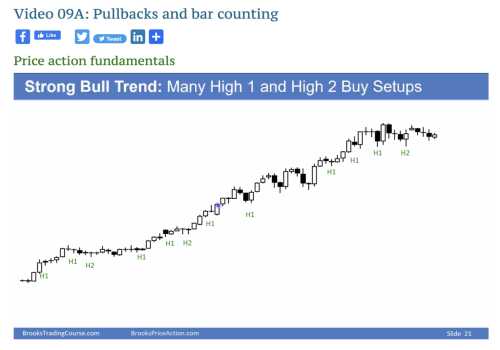The support forum is built with (1) General and FAQ forums for common trading queries received from aspiring and experienced traders, and (2) forums for course video topics. How to Trade Price Action and How to Trade Forex Price Action videos are consolidated into common forums.
Brooks Trading Course social media communities
Hi all!
So far so good, I love Al's course.
I've been watching videos on Pullbacks and Bar Counting (09 A-B-C) and I don't catch the meaning of Low 1-2-3 and High 1-2-3.
When Al talks about a H1 for instance, the mark is on the low. I don't understand why a low is mark as a high.
Could anyone explain me this principle? That's the first thing I don't understand in the course.
Thanks a lot!
I had the same difficulty with this topic. I started the course a week or so ago so I'll give my admittedly amateur take on this. If I understand correctly, if we look at a pullback in an uptrend for example, the first bar with a low beneath the low of the prior bar initiates the pullback. For now that's all it is, a lower low. It is a potential signal bar. It's a potential signal bar because it does not become a signal until we know what happens with the next bar. If the next bar makes a higher high, the bar making the higher high becomes a H1 entry and the prior bar is the "signal bar." The bar taking out the high of the prior becomes a H1 because it is the first attempt in the pullback to move higher. If the next bar does not make a higher high, the following bar (the 3rd bar in our scenario)has the potential to become a H1 bar...only known after the fact once we see what happens with the next bar. this gets confusing without a chart so here is my best attempt to illustrate this concept. I numbered the process 1-4. Hope this helps. If anyone sees errors in my understanding please don't hesitate to point them out.
If anyone sees errors in my understanding please don't hesitate to point them out.
Your understanding is spot on!
When Al talks about a H1 for instance, the mark is on the low. I don't understand why a low is mark as a high.
Not sure what you mean, why don't you paste a chart to better explain?
Thanks for the reply. Appreciate someone who's been around for several years confirming I understand the concept correctly. Now on to the next concept...
Good explanation.
You mention that the higher high becomes the entry bar. Of course it is only an entry bar for traders who enter. Some traders may wait for a h2, or simply not enter because they dont like the setup.
Of course it is only an entry bar for traders who enter.
Beware of that. A bar is an entry bar (EB) of a Signal bar (SB) no matter who took it and as such it has implications for every trader.
In the chart attached, the EB is closing near the high (COH) after what seems to be a bear trap (consecutive bear bars followed by a bull bar COH). We actually can't see many bars to the left but let assume it is indeed a bear trap, for the shake of the argument.
By being COH the EB is signaling to every one that the bears are exiting so you can buy the close (therefore the EB becomes a SB for another buy), below the following doji (PB), or the BO PB two bars later, and you can do that because after seeing the EB COH, you expect a second leg up.
So in this case, the EB has the following implications:
* Bull traders who bought the trap, they get more confident and might swing part.
* Bulls on the sidelines: they look for reasons to enter (given above)
* Bears who are still short: they exit exactly at the same place where bulls enter (this is why the second leg can be expected).
* Bears who were looking to short: they now wait.
All this information was given by the entry bar in that particular context.
When Al talks about a H1 for instance, the mark is on the low. I don't understand why a low is mark as a high.
Not sure what you mean, why don't you paste a chart to better explain?
As an example, you can see 'Video 09A: Pullbacks and bar counting' at 33:00.
I watched part of this video again (and I've read David's post), and I don't know why, I don't understand the concept.
The marked H1 have lower high. I don't catch this.
No big deal, this is the first thing I don't understand in Al's course. I'm going to keep watching the lessons and anyway, I'll watch this whole thing several times over the next few months. I'll figure it out eventually.
Ok, sorry, I am a little lost because I still don't know where is the problem 🙂 but, yeah, almost for sure you will find out in future watchs!
Came up with this issue and solved here:
At first I too had trouble with this concept. I struggled with it before finally figuring it out. I wish I would have had your explanation. Very clear. Well done Mr. Perkins.
Hi
The mark is done on the bar that is broken. Is the next bar breaks the high a previous bar, the bar "broken" is marked as H1 (and not the bar that breaks).

